TED英语演讲:拯救生命的温暖拥抱
TED英语演讲:生命无限,勇往直前_英语演讲稿_
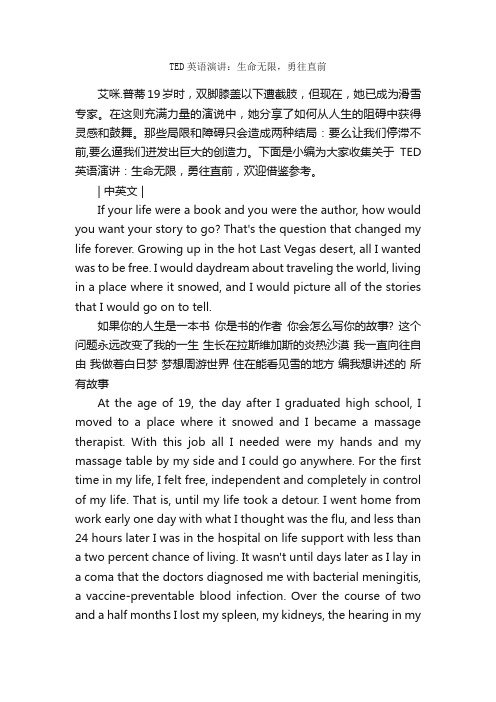
TED英语演讲:生命无限,勇往直前艾咪.普蒂19岁时,双脚膝盖以下遭截肢,但现在,她已成为滑雪专家。
在这则充满力量的演说中,她分享了如何从人生的阻碍中获得灵感和鼓舞。
那些局限和障碍只会造成两种结局:要么让我们停滞不前,要么逼我们迸发出巨大的创造力。
下面是小编为大家收集关于TED 英语演讲:生命无限,勇往直前,欢迎借鉴参考。
| 中英文 |If your life were a book and you were the author, how would you want your story to go? That's the question that changed my life forever. Growing up in the hot Last Vegas desert, all I wanted was to be free. I would daydream about traveling the world, living in a place where it snowed, and I would picture all of the stories that I would go on to tell.如果你的人生是一本书你是书的作者你会怎么写你的故事? 这个问题永远改变了我的一生生长在拉斯维加斯的炎热沙漠我一直向往自由我做着白日梦梦想周游世界住在能看见雪的地方编我想讲述的所有故事At the age of 19, the day after I graduated high school, I moved to a place where it snowed and I became a massage therapist. With this job all I needed were my hands and my massage table by my side and I could go anywhere. For the first time in my life, I felt free, independent and completely in control of my life. That is, until my life took a detour. I went home from work early one day with what I thought was the flu, and less than24 hours later I was in the hospital on life support with less thana two percent chance of living. It wasn't until days later as I lay in a coma that the doctors diagnosed me with bacterial meningitis, a vaccine-preventable blood infection. Over the course of two and a half months I lost my spleen, my kidneys, the hearing in myleft ear and both of my legs below the knee.19岁那年在我从高中毕业后我搬到了能见到雪的地方我成为一名按摩师这份工作只需要双手以及身边的按摩桌而且我可以去任何地方有生以来头一次我感到自由独立对生活充满把握直到人生出现了一个转折一天我下班比往常早以为自己得了流感 24小时不到我就进了医院生命垂危只有2%的存活几率之后的几天我陷入昏迷医生诊断我得了细菌性脑膜炎疫苗可预防性血液感染在为期两个半月的治疗中我切除了脾和肾左耳失聪膝盖以下截肢When my parents wheeled me out of the hospital I felt like I had been pieced back together like a patchwork doll. I thought the worst was over until weeks later when I saw my new legs for the first time. The calves were bulky blocks of metal with pipes bolted together for the ankles and a yellow rubber foot with a raised rubber line from the toe to the ankle to look like a vein. I didn't know what to expect, but I wasn't expecting that.当父母把我推出医院时我感到自己被重新拼凑起来像一个拼布娃娃我以为最惨的事已完结直到我第一次见到自己的新腿小腿是笨重的金属块脚踝用管子和螺丝固定外加黄色的橡胶脚突起的橡胶线从脚趾延伸到脚踝为了使它们看起来像血管我不知道我想要的结果是什么但绝不会是这个With my mom by my side and tears streaming down our faces, I strapped on these chunky legs and I stood up. They were so painful and so confining that all I could think was, how am I ever going to travel the world in these things? How was I ever going to live the life full of adventure and stories, as I always wanted? And how was I going to snowboard again?妈妈站在我旁边两个人泪水肆意我绑上这两条粗短腿然后站起来它们让我感到十分痛苦,并且充满限制我脑子里只有一个想法:用这些破玩意我怎么能周游世界? 我如何才能过我一直想要的异彩纷呈的生活?That day, I went home, I crawled into bed and this is what my life looked like for the next few months: me passed out, escaping from reality, with my legs resting by my side. I was absolutely physically and emotionally broken.我如何才能再玩单板滑雪? 那天,我回到家,爬上床这是我接下来几个月的生活状态: 我躺在床上, 淡出生活逃离现实我的腿放在床边.我在生理上和心理上完全崩溃了But I knew that in order to move forward, I had to let go of the old Amy and learn to embrace the new Amy. And that is when it dawned on me that I didn't have to be five-foot-five anymore.I could be as tall as I wanted! (Laughter) (Applause) Or as short as I wanted, depending on who I was dating. (Laughter) And if I snowboarded again, my feet aren't going to get cold. (Laughter) And best of all, I thought, I can make my feet the size of all the shoes that are on the sales rack. (Laughter) And I did! So there were benefits here.但是我知道为了向前走我必须放开过去的艾米学着接受新的艾米那时我突然想到我再也不只有5.5英尺高了我可以想多高有多高 (笑声)(掌声) 或者想多矮有多矮这得看我和谁约会 (笑声) 如果我再玩单板滑雪脚再也不会冷 (笑声) 我觉得最棒的是我可以调整脚的大小来适合货架上任何尺码的鞋子 (笑声) 我真那么干了! 所以这还是有些好处的It was this moment that I asked myself that life-defining question: If my life were a book and I were the author, how would I want the story to go? And I began to daydream. I daydreamed like I did as a little girl and I imagined myself walking gracefully, helping other people through my journey and snowboarding again. And I didn't just see myself carving down a mountain of powder, I could actually feel it. I could feel the wind against my face and the beat of my racing heart as if it were happening in that very moment. And that is when a new chapter in my lifebegan.那一刻我问了自己一个决定人生走向的问题如果人生是一本书而我是作者我会怎么写这个故事? 我开始做白日梦想小时候那样做梦我想象自己优雅地前行在路途中帮助别人再次玩单板滑雪我并不是仅仅看到自己从山上滑下来我可以真切感受到那个场景我可以感受到风扑面而来感受到心脏的韵律如同那一刻正在真实发生.那就是我开启人生新篇章的时刻Four months later I was back up on a snowboard, although things didn't go quite as expected: My knees and my ankles wouldn't bend and at one point I traumatized all the skiers on the chair lift when I fell and my legs, still attached to my snowboard — (Laughter) — went flying down the mountain, and I was on top of the mountain still. I was so shocked, I was just as shocked as everybody else, and I was so discouraged, but I knew that if I could find the right pair of feet that I would be able to do this again. And this is when I learned that our borders and our obstacles can only do two things: one, stop us in our tracks or two, force us to get creative.4个月之后,我重拾单板滑雪虽然事情并不像我期待的那样我的膝盖和脚踝无法弯曲在某一点上我吓坏了升降椅上所有的滑雪者(笑声)就是当我摔倒时,我的腿还连着滑板(笑声) 它们一起飞落到山脚而我依然在山顶(笑声)我被惊到了同其他人一样我惊呆了而且很失落但是我知道如果我找到了两条合适的腿我完全可以成功这时我明白了艰难险阻只能做两件事:一是将我们困在原来的轨道二是迫使我们充满创造力I did a year of research, still couldn't figure out what kind of legs to use, couldn't find any resources that could help me. So I decided to make a pair myself. My leg maker and I put random parts together and we made a pair of feet that I could snowboard in. As you can see, rusted bolts, rubber, wood and neon pink ducttape. And yes, I can change my toenail polish. It was these legs and the best 21st birthday gift I could ever receive —a new kidney from my dad —that allowed me to follow my dreams again. I started snowboarding, then I went back to work, then I went back to school.我研究了一年仍然不知道用什么样的腿也找不到任何有用的资源于是我决定自己做一副假腿我和制作者把各种部件拼在一起做了两条可以玩滑板的腿你可以看到生锈的螺栓、橡胶、木头和荧光粉胶带没错我可以换指甲颜色这双假腿以及我21岁生日收到的最好礼物————我爸爸的一个肾让我再次追逐梦想.我开始玩单板滑雪我重新工作并回到学校Then in 20xx I cofounded a nonprofit organization for youth and young adults with physical disabilities so they could get involved with action sports. From there, I had the opportunity to go to South Africa, where I helped to put shoes on thousands of children's feet so they could attend school.20xx年我创办了一个非盈利组织用来救助身体残疾的年轻人使他们能再次参加体育运动从那时起我有机会前往南非给千百儿童带来鞋子这样他们就可以去上学And just this past February, I won two back-to-back World Cup gold medals — (Applause) — which made me the highest ranked adaptive female snowboarder in the world.在刚刚过去的二月我相继取得两块世界金牌 (掌声) ——这使我成为世界上最高级别的残疾人女子单板滑雪运动员.Eleven years ago, when I lost my legs, I had no idea what to expect. But if you ask me today, if I would ever want to change my situation, I would have to say no. Because my legs haven't disabled me, if anything they've enabled me. They've forced me to rely on my imagination and to believe in the possibilities, and that's why I believe that our imaginations can be used as toolsfor breaking through borders, because in our minds, we can do anything and we can be anything.20xx年前当我失去腿时我不知道该期盼什么但是如果你现在问我是否愿意换个人生我会回答不因为我的双腿并没有阻碍我如果说它们给我带来了什么那就是它们让我依靠想象力让我相信一切皆有可能这就是为什么我相信想象可以成为工具用来冲破障碍因为在脑子里我们可以做任何事可以成为任何人It's believing in those dreams and facing our fears head-on that allows us to live our lives beyond our limits. And although today is about innovation without borders, I have to say that in my life, innovation has only been possible because of my borders. I've learned that borders are where the actual ends, but also where the imagination and the story begins.相信梦想直面恐惧能够让我们的生活超出局限虽然今天在讲无边界创新但我不得不说在我的生命里是我自身的种种局限让不可能变成可能我知道这些局限才是现实结束想象产生故事开始的地方So the thought that I would like to challenge you with today is that maybe instead of looking at our challenges and our limitations as something negative or bad, we can begin to look at them as blessings, magnificent gifts that can be used to ignite our imaginations and help us go further than we ever knew we could go. It's not about breaking down borders. It's about pushing off of them and seeing what amazing places they might bring us. Thank you.所以今天我想让你们挑战的是与其把挑战、局限看做不利或者坏事我们可以把它们看做恩惠可以点亮想象的神奇礼物能帮助我们走得更远远到我们从未想过这不是要打破局限而是把局限推得更广然后看看它们能把我们带到怎样美好的地方谢谢 (掌声)。
TED《让我们来谈谈死亡》英语演讲稿
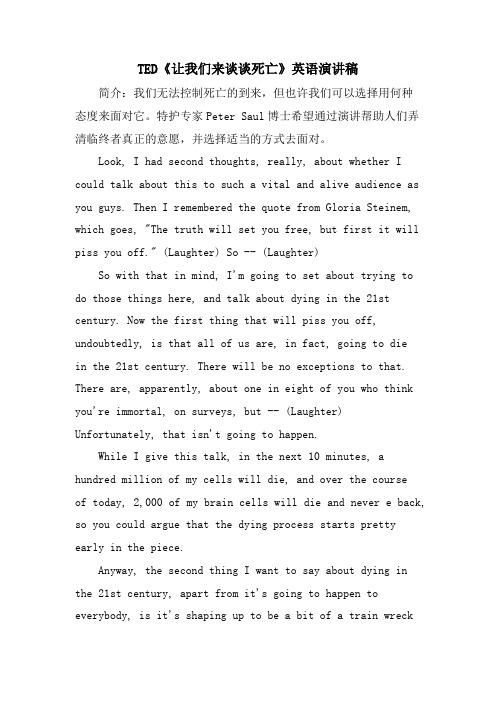
TED《让我们来谈谈死亡》英语演讲稿简介:我们无法控制死亡的到来,但也许我们可以选择用何种态度来面对它。
特护专家Peter Saul博士希望通过演讲帮助人们弄清临终者真正的意愿,并选择适当的方式去面对。
Look, I had second thoughts, really, about whether I could talk about this to such a vital and alive audience as you guys. Then I remembered the quote from Gloria Steinem, which goes, "The truth will set you free, but first it will piss you off." (Laughter) So -- (Laughter)So with that in mind, I'm going to set about trying to do those things here, and talk about dying in the 21st century. Now the first thing that will piss you off, undoubtedly, is that all of us are, in fact, going to diein the 21st century. There will be no exceptions to that. There are, apparently, about one in eight of you who think you're immortal, on surveys, but -- (Laughter) Unfortunately, that isn't going to happen.While I give this talk, in the next 10 minutes, a hundred million of my cells will die, and over the courseof today, 2,000 of my brain cells will die and never e back, so you could argue that the dying process starts prettyearly in the piece.Anyway, the second thing I want to say about dying inthe 21st century, apart from it's going to happen to everybody, is it's shaping up to be a bit of a train wreckfor most of us, unless we do something to try and reclaim this process from the rather inexorable trajectory thatit's currently on.So there you go. That's the truth. No doubt that will piss you off, and now let's see whether we can set you free.I don't promise anything. Now, as you heard in the intro, I work in intensive care, and I think I've kind of lived through the heyday of intensive care. It's been a ride, man. This has been fantastic. We have machines that go ping. There's many of them up there. And we have some wizard technology which I think has worked really well, and over the course of the time I've worked in intensive care, the death rate for males in Australia has halved, and intensive care has had something to do with that. Certainly, a lot of the technologies that we use have got something to do with that.So we have had tremendous suess, and we kind of got caught up in our own suess quite a bit, and we startedusing expressions like "lifesaving." I really apologize to everybody for doing that, because obviously, we don't. What we do is prolong people's lives, and delay death, and redirect death, but we can't, strictly speaking, save lives on any sort of permanent basis.And what's really happened over the period of time that I've been working in intensive care is that the peoplewhose lives we started saving back in the '70s, '80s, and '90s, are now ing to die in the 21st century of diseases that we no longer have the answers to in quite the way we did then.So what's happening now is there's been a big shift in the way that people die, and most of what they're dying of now isn't as amenable to what we can do as what it used to be like when I was doing this in the '80s and '90s.So we kind of got a bit caught up with this, and we haven't really squared with you guys about what's really happening now, and it's about time we did. I kind of woke up to this bit in the late '90s when I met this guy. This guy is called Jim, Jim Smith, and he looked like this. I was called down to the ward to see him. His is the little hand. I was called down to the ward to see him by a respiratory physician. He said, "Look, there's a guy down here. He's got pneumonia, and he looks like he needs intensive care. His daughter's here and she wants everything possible to be done." Which is a familiar phrase to us. So I go down to the ward and see Jim, and his skin his translucent like this. You can see his bones through the skin. He's very, very thin, and he is, indeed, very sick with pneumonia, and he's too sick to talk to me, so I talk to his daughter Kathleen, and I say to her, "Did you and Jim ever talk about what you would want done if heended up in this kind of situation?" And she looked at me and said,"No, of course not!" I thought, "Okay. Take this steady." And I got talking to her, and after a while, she said to me, "You know, we always thought there'd be time."Jim was 94. (Laughter) And I realized that something wasn't happening here. There wasn't this dialogue going on that I imagined was happening. So a group of us started doing survey work, and we looked at four and a half thousand nursing home residents in Newcastle, in the Newcastle area, and discovered that only one in a hundredof them had a plan about what to do when their hearts stopped beating. One in a hundred. And only one in 500 of them had plan about what to do if they became seriously ill. And I realized, of course, this dialogue is definitely not ourring in the public at large.。
ted演讲稿(精选13篇)
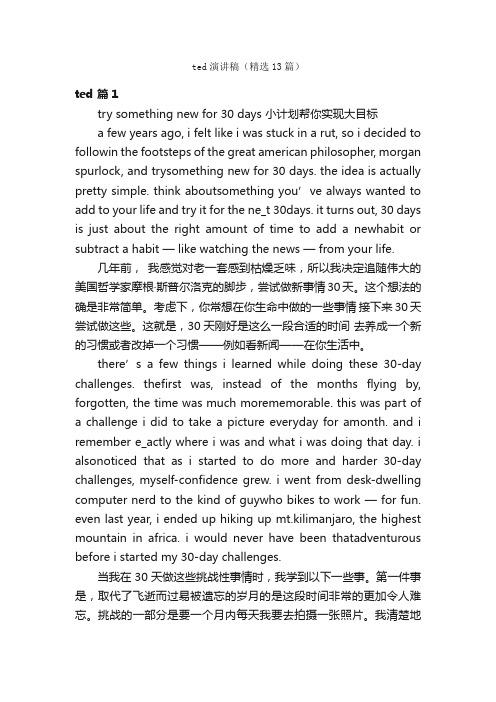
ted演讲稿(精选13篇)ted 篇1try something new for 30 days 小计划帮你实现大目标a few years ago, i felt like i was stuck in a rut, so i decided to followin the footsteps of the great american philosopher, morgan spurlock, and trysomething new for 30 days. the idea is actually pretty simple. think aboutsomething you’ve always wanted to add to your life and try it for the ne_t 30days. it turns out, 30 days is just about the right amount of time to add a newhabit or subtract a habit — like watching the news — from your life.几年前,我感觉对老一套感到枯燥乏味,所以我决定追随伟大的美国哲学家摩根·斯普尔洛克的脚步,尝试做新事情30天。
这个想法的确是非常简单。
考虑下,你常想在你生命中做的一些事情接下来30天尝试做这些。
这就是,30天刚好是这么一段合适的时间去养成一个新的习惯或者改掉一个习惯——例如看新闻——在你生活中。
there’s a few things i learned while doing these 30-day challenges. thefirst was, instead of the months flying by, forgotten, the time was much morememorable. this was part of a challenge i did to take a picture everyday for amonth. and i remember e_actly where i was and what i was doing that day. i alsonoticed that as i started to do more and harder 30-day challenges, myself-confidence grew. i went from desk-dwelling computer nerd to the kind of guywho bikes to work — for fun. even last year, i ended up hiking up mt.kilimanjaro, the highest mountain in africa. i would never have been thatadventurous before i started my 30-day challenges.当我在30天做这些挑战性事情时,我学到以下一些事。
拯救生命英语作文
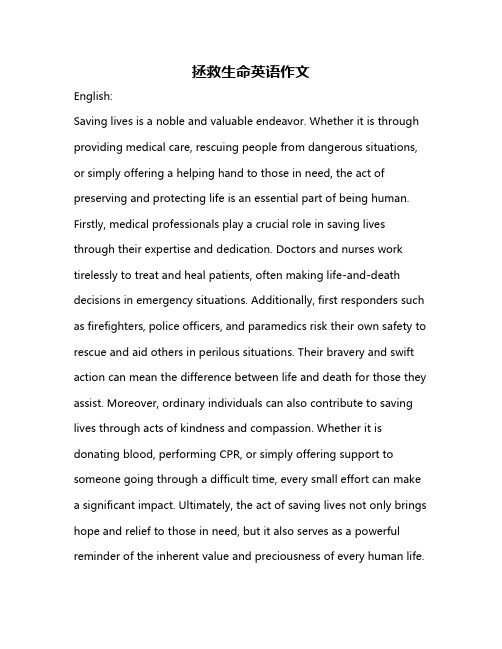
拯救生命英语作文English:Saving lives is a noble and valuable endeavor. Whether it is through providing medical care, rescuing people from dangerous situations, or simply offering a helping hand to those in need, the act of preserving and protecting life is an essential part of being human. Firstly, medical professionals play a crucial role in saving lives through their expertise and dedication. Doctors and nurses work tirelessly to treat and heal patients, often making life-and-death decisions in emergency situations. Additionally, first responders such as firefighters, police officers, and paramedics risk their own safety to rescue and aid others in perilous situations. Their bravery and swift action can mean the difference between life and death for those they assist. Moreover, ordinary individuals can also contribute to saving lives through acts of kindness and compassion. Whether it is donating blood, performing CPR, or simply offering support to someone going through a difficult time, every small effort can make a significant impact. Ultimately, the act of saving lives not only brings hope and relief to those in need, but it also serves as a powerful reminder of the inherent value and preciousness of every human life.中文翻译:拯救生命是一项高尚而有价值的事业。
ted演讲稿保护自然英语

ted演讲稿保护自然英语Ladies and gentlemen,Today, I am honored to stand before you to talk about the importance of protecting nature. As we all know, the natural environment is essential for our survival and well-being. It provides us with clean air, fresh water, and a variety of resources that support our lives. However, in recent years, human activities have greatly impacted the environment, leading to deforestation, pollution, and loss of biodiversity. It is crucial that we take action to protect our planet and preserve its natural beauty for future generations.First of all, we need to raise awareness about the importance of protecting nature. Education is key in this aspect, as people need to understand the impact of their actions on the environment. By promoting environmental education in schools and communities, we can instill a sense of responsibility and stewardship towards nature. Additionally, we should also engage in public campaigns and initiatives to raise awareness about environmental issues and promote sustainable practices.Secondly, we must work towards conserving and restoring natural habitats. This can be achieved through the establishment of protected areas and national parks, where wildlife and natural ecosystems can thrive without human interference. Furthermore, reforestation and afforestation efforts are crucial in restoring degraded landscapes and increasing the green cover. By protecting and restoring natural habitats, we can safeguard biodiversity and ensure the well-being of countless plant and animal species.Moreover, we need to promote sustainable development and responsible resource management. This involves adopting practices that minimize waste, reduce pollution, and conserve natural resources. By embracing renewable energy sources, implementing eco-friendly technologies, and promoting sustainable agriculture, we can reduce our impact on the environment and mitigate the effects of climate change. Additionally, we should also support sustainable practices in industries and businesses to ensure that economic growth is not achieved at the expense of the environment.Lastly, we must advocate for policies and regulations that protect nature. Governments and organizations play a crucial role in enacting laws and regulations that safeguard the environment. This includes measures to address deforestation, regulate pollution, and promote sustainable land use. By advocating for environmental policies and holding governments and corporations accountable, we can ensure that the natural environment is protected and preserved for future generations.In conclusion, protecting nature is a shared responsibility that requires collective action from individuals, communities, and governments. By raising awareness, conserving habitats, promoting sustainable practices, and advocating for policies, we can work towards a sustainable and thriving planet. Let us all commit to protecting nature and preserving its beauty for the benefit of current and future generations.尊敬的各位,今天,我很荣幸站在这里,与大家讨论保护自然的重要性。
TED演讲稿-拥抱焦虑
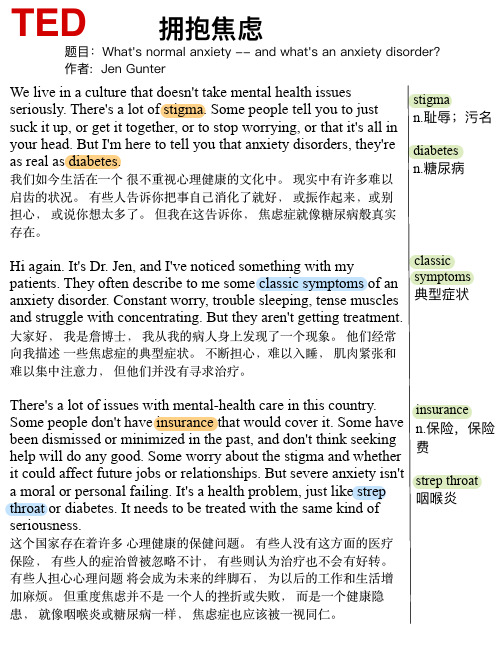
TED题⽬:What's normal anxiety -- and what's an anxiety disorder?作者: Jen Gunter拥抱焦虑We live in a culture that doesn't take mental health issues seriously. There's a lot of stigma. Some people tell you to just suck it up, or get it together, or to stop worrying, or that it's all in your head. But I'm here to tell you that anxiety disorders, they're as real as diabetes.我们如今⽣活在⼀个 很不重视⼼理健康的⽂化中。
现实中有许多难以启齿的状况。
有些⼈告诉你把事⾃⼰消化了就好, 或振作起来,或别担⼼, 或说你想太多了。
但我在这告诉你, 焦虑症就像糖尿病般真实存在。
Hi again. It's Dr. Jen, and I've noticed something with my patients. They often describe to me some classic symptoms of an anxiety disorder. Constant worry, trouble sleeping, tense muscles and struggle with concentrating. But they aren't getting treatment.⼤家好, 我是詹博⼠, 我从我的病⼈⾝上发现了⼀个现象。
他们经常向我描述 ⼀些焦虑症的典型症状。
TED英语演讲:学会拥抱别人-最新范文

TED英语演讲:学会拥抱别人你会拥抱别人吗?拥抱别人就是拥抱自己,就是给自己温暖。
Newton 女士讲述了作为一个演员演绎很多永远不同自我的角色的经历,这些经历让她变得温暖而有智慧。
下面是小编为大家收集关于TED英语演讲:学会拥抱别人,欢迎借鉴参考。
学会拥抱别人,就是给自己温暖演讲者:Thandie NewtonEmbracing otherness. When I first heard this theme, I thought, well, embracing otherness is embracing myself. And the journey to that place of understanding and acceptance has been an interesting one for me, and it’s given me an insight into the whole notion of self, which I think is worth sharing with you today.拥抱他人,当我第一次听到这个主题时我觉得拥抱他人,就是拥抱我自己。
对于我来说通往理解和接纳的路是十分有意思的,并且让我对“自我”这一概念有了深刻的理解。
我想这值得在今天和你们分享。
We each have a self, but I don’t think that we’re born with one. You know how newborn babies believe they’re part of everything; they’re not separate? Well that fundamental sense of oneness is lost on us very quickly. It’s like that initial stage is over -- oneness: infancy, unformed, primitive. It’sno longer valid or real. What is real is separateness, and at some point in early babyhood, the idea of self starts to form.我们都有一个自我但我并不认为这是与生俱来的。
关爱生命演讲稿:传递温暖,拯救生命
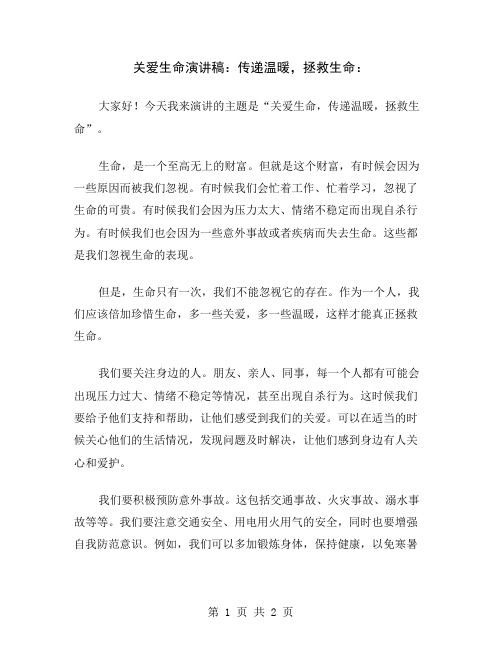
关爱生命演讲稿:传递温暖,拯救生命:大家好!今天我来演讲的主题是“关爱生命,传递温暖,拯救生命”。
生命,是一个至高无上的财富。
但就是这个财富,有时候会因为一些原因而被我们忽视。
有时候我们会忙着工作、忙着学习,忽视了生命的可贵。
有时候我们会因为压力太大、情绪不稳定而出现自杀行为。
有时候我们也会因为一些意外事故或者疾病而失去生命。
这些都是我们忽视生命的表现。
但是,生命只有一次,我们不能忽视它的存在。
作为一个人,我们应该倍加珍惜生命,多一些关爱,多一些温暖,这样才能真正拯救生命。
我们要关注身边的人。
朋友、亲人、同事,每一个人都有可能会出现压力过大、情绪不稳定等情况,甚至出现自杀行为。
这时候我们要给予他们支持和帮助,让他们感受到我们的关爱。
可以在适当的时候关心他们的生活情况,发现问题及时解决,让他们感到身边有人关心和爱护。
我们要积极预防意外事故。
这包括交通事故、火灾事故、溺水事故等等。
我们要注意交通安全、用电用火用气的安全,同时也要增强自我防范意识。
例如,我们可以多加锻炼身体,保持健康,以免寒暑病症发生;可以增强环保意识,保护我们的自然环境,避免某些自然灾害的发生。
我们要关注疾病防治。
疾病是生命的大敌,我们要积极预防疾病,加强健康管理,不吃不健康的食物,保持足够的锻炼。
如果身体出现不适,我们要及时就医,不要忽视身体的任何一点异样。
同时也要提高对染传染病、恶性肿瘤、心脑血管疾病等的警惕性,及时发现病情并进行治疗。
这不仅是对自己负责,也是对家人、社会负责。
,关爱生命,传递温暖,拯救生命,需要每一个人的共同努力。
让我们从自己做起,从身边做起,让关爱和温暖传遍每一个角落。
相信在我们的努力下,我们一定可以拯救更多的生命,让世界变得更加美好!谢谢大家!。
简单的ted英文演讲稿珍爱生命
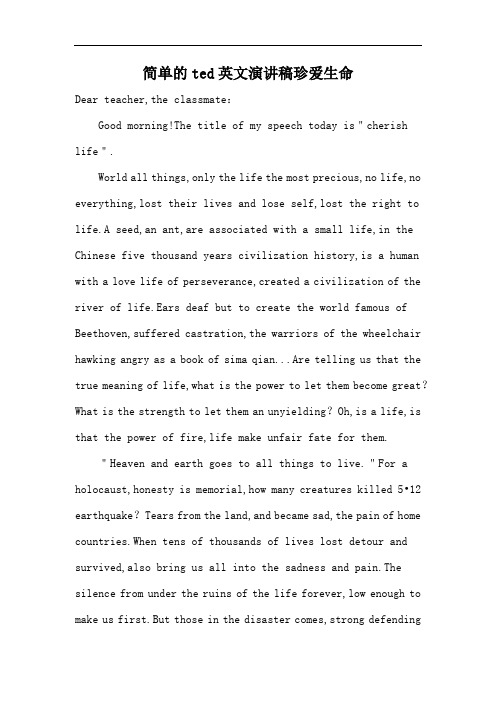
简单的ted英文演讲稿珍爱生命Dear teacher,the classmate:Good morning!The title of my speech today is"cherish life".World all things,only the life the most precious,no life,no everything,lost their lives and lose self,lost the right to life.A seed,an ant,are associated with a small life,in the Chinese five thousand years civilization history,is a human with a love life of perseverance,created a civilization of the river of life.Ears deaf but to create the world famous of Beethoven,suffered castration,the warriors of the wheelchair hawking angry as a book of sima qian...Are telling us that the true meaning of life,what is the power to let them become great?What is the strength to let them an unyielding?Oh,is a life,is that the power of fire,life make unfair fate for them."Heaven and earth goes to all things to live."For a holocaust,honesty is memorial,how many creatures killed 5•12 earthquake?Tears from the land,and became sad,the pain of home countries.When tens of thousands of lives lost detour and survived,also bring us all into the sadness and pain.The silence from under the ruins of the life forever,low enough to make us first.But those in the disaster comes,strong defendingtheir warriors don't let a person more reverence of life with others?More save andKneel to cry"to save a"fire fighter JingLiJie,saved more than 10 students themselves trapped under the rubble 50 hours lost his right leg 13-year-old girl He Cuiqing,body is smashed into three sections and the hands will still three students hug tightly in the bosom of the people's teacher to qian...Life is just a process,or even a transient process,and even a brief like sky in blanking of a meteor,then we should not let life shine more light?Montaigne in his"love life"wrote:"I want to hurry up quickly,to retain the fleeting days;I think by the efficient use of time to make up for the passage of time is in a hurry.The rest of the life is short,the more I want to make it have a plentiful full."Plug Seneca once said:"if you can good at using,life is long."Yes,life to man only once,when and where the why the end of life,who also cannot predict.But the great man who left behind a monument,philosopher,leaving behind the great deep thoughts,the poet left behind breathtaking emotion,painter magnificent precious inheritance left behind...Now that we are a member of the sentient beings,came to this world,should let oneself all thoughts,feelings,character inthe ways of life in full bloom in March picturesque fields,in the lonely life on the road,with songs to sing a warm and fulfilling life.So,is good to life,not a time of life.。
TED英语演讲:拯救生命的温暖拥抱
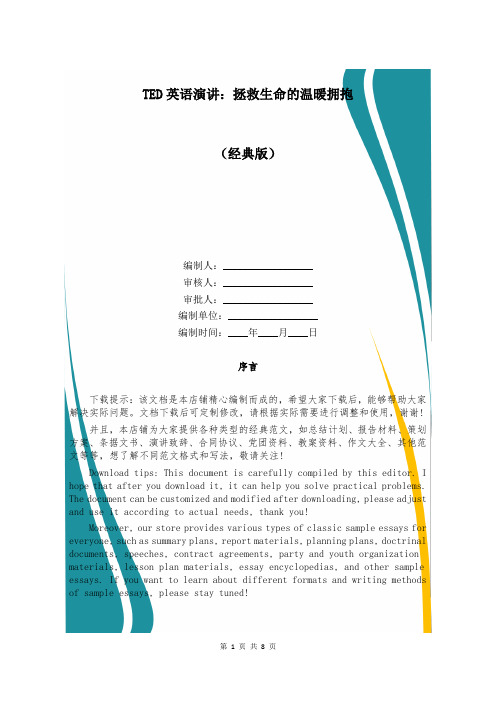
TED英语演讲:拯救生命的温暖拥抱(经典版)编制人:__________________审核人:__________________审批人:__________________编制单位:__________________编制时间:____年____月____日序言下载提示:该文档是本店铺精心编制而成的,希望大家下载后,能够帮助大家解决实际问题。
文档下载后可定制修改,请根据实际需要进行调整和使用,谢谢!并且,本店铺为大家提供各种类型的经典范文,如总结计划、报告材料、策划方案、条据文书、演讲致辞、合同协议、党团资料、教案资料、作文大全、其他范文等等,想了解不同范文格式和写法,敬请关注!Download tips: This document is carefully compiled by this editor. I hope that after you download it, it can help you solve practical problems. The document can be customized and modified after downloading, please adjust and use it according to actual needs, thank you!Moreover, our store provides various types of classic sample essays for everyone, such as summary plans, report materials, planning plans, doctrinal documents, speeches, contract agreements, party and youth organization materials, lesson plan materials, essay encyclopedias, and other sample essays. If you want to learn about different formats and writing methods of sample essays, please stay tuned!TED英语演讲:拯救生命的温暖拥抱每一年全世界出世的20XX万早产婴儿中,贴近400万活但是第一个月就离世了,特别是在这些贫困地域。
感动人心的TED英语演讲稿:二十岁,这些话对你很重要

感动人心的TED英语演讲稿:二十岁,这些话对你很重要Dear all,Today, I want to talk about something that is very close to our hearts- being twenty years old. For most of us, it is a phase in our lives where we undergo a lot of changes, challenges, and experiences that shape us for the rest of our lives. It is a time when we start making decisions thataffect our future, and the choices we make can impact therest of our lives. So, what are the things that are important to know when we are twenty?Firstly, it is important to understand that success is not an overnight phenomenon. We live in a world where social media platforms showcase success stories that make us believe that success is easy to achieve. However, every successful person has put in a lot of hard work and dedication towards their goals. It is essential to set realistic and achievable goals for ourselves and work towards them with determination and perseverance.Secondly, it is important to acknowledge that failure is a part of life. Most of us are afraid of failing, but it isinevitable. We learn from our failures, and it helps us become better, and stronger individuals. Failing does not make us weak; in fact, it makes us more resilient and determined towards our goals.Thirdly, it is important to cherish our relationships, family, and friends. They are our support system, and they will be there for us when we need them the most. Be grateful for the people in your life, and take out time for them. Nurture your relationships and give them the love and care that they deserve.Fourthly, it is important to find your passion and pursue it with all your heart. It is not easy to decide what you want to do with your life, but it is important to listen to your heart and follow your dreams. Do not let societal norms or family pressure dictate your choices. Pursue what makes you happy and fulfilled.Lastly, it is important to take care of your physical and mental well-being. Our bodies and minds are interconnected.It is essential to eat healthy, exercise regularly, and take out time for self-care. Mental health is equally important, and we should not hesitate to seek help when needed.In conclusion, being twenty can be overwhelming, but itis also a time to discover ourselves, learn, and grow. Lifeis a journey, and it is up to us to make it a memorable one. Remember, success is not the key to happiness, but happinessis the key to success. So, live life with a positive attitude, be kind, and never stop learning.Thank you.。
【最新推荐】TED英语演讲稿:拥抱他人,拥抱自己-实用word文档 (7页)

本文部分内容来自网络整理,本司不为其真实性负责,如有异议或侵权请及时联系,本司将立即删除!== 本文为word格式,下载后可方便编辑和修改! ==TED英语演讲稿:拥抱他人,拥抱自己Thandie Newton Embracing otherness, embracing myself拥抱他人,拥抱自己Embracing otherness. When I first heard this theme, I thought, well, embracing otherness is embracing myself. And the journey tothat place of understanding and acceptance has been an interestingone for me, and it's given me an insight into the whole notion of self, which I think is worth sharing with you today.拥抱他类。
当我第一次听说这个主题时,我心想,拥抱他类不就是拥抱自己吗。
我个人懂得理解和接受他类的经历很有趣,让我对于“自己”这个词也有了新的认识,我想今天在这里和你们分享下我的心得体会。
We each have a self, but I don't think that we're born with one. You know how newborn babies believe they're part of everything;they're not separate? Well that fundamental sense of oneness is lost on us very quickly. It's like that initial stage is over -- oneness: infancy, unformed, primitive. It's no longer valid or real. What is real is separateness, and at some point in early babyhood, the ideaof self starts to form. Our little portion of oneness is given a name, is told all kinds of things about itself, and these details, opinions and ideas become facts, which go towards building ourselves, our identity. And that self becomes the vehicle for navigating our social world. But the self is a projection based on other people's projections. Is it who we really are? Or who we really want to be, or should be?我们每个人都有个自我,但并不是生来就如此的。
专业英语 TED演讲 9.11 healing The mothers who found forgiveness, friendship
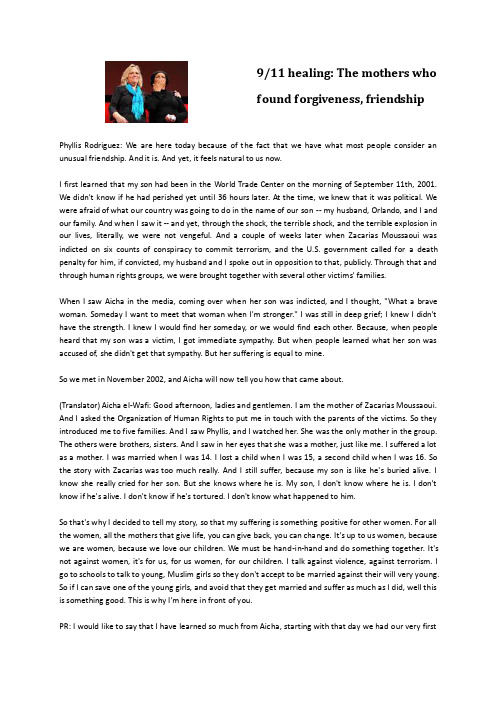
9/11 healing: The mothers whof ound f orgiveness, friendshipPhyllis Rodriguez: We are here today because of the fact that we have what most people consider an unusual friendship. And it is. And yet, it feels natural to us now.I first learned that my son had been in the World Trade Center on the morning of September 11th, 2001. We didn't know if he had perished yet until 36 hours later. At the time, we knew that it was political. We were afraid of what our country was going to do in the name of our son -- my husband, Orlando, and I and our family. And when I saw it -- and yet, through the shock, the terrible shock, and the terrible explosion in our lives, literally, we were not vengeful. And a couple of weeks later when Zacarias Moussaoui was indicted on six counts of conspiracy to commit terrorism, and the U.S. government called for a death penalty for him, if convicted, my husband and I spoke out in opposition to that, publicly. Through that and through human rights groups, we were brought together with several other victims' families.When I saw Aicha in the media, coming over when her son was indicted, and I thought, "What a brave woman. Someday I want to meet that woman when I'm stronger." I was still in deep grief; I knew I didn't have the strength. I knew I would find her someday, or we would find each other. Because, when people heard that my son was a victim, I got immediate sympathy. But when people learned what her son was accused of, she didn't get that sympathy. But her suffering is equal to mine.So we met in November 2002, and Aicha will now tell you how that came about.(Translator) Aicha el-Wafi: Good afternoon, ladies and gentlemen. I am the mother of Zacarias Moussaoui. And I asked the Organization of Human Rights to put me in touch with the parents of the victims. So they introduced me to five families. And I saw Phyllis, and I watched her. She was the only mother in the group. The others were brothers, sisters. And I saw in her eyes that she was a mother, just like me. I suffered a lot as a mother. I was married when I was 14. I lost a child when I was 15, a second child when I was 16. So the story with Zacarias was too much really. And I still suffer, because my son is like he's buried alive. I know she really cried for her son. But she knows where he is. My son, I don't know where he is. I don't know if he's alive. I don't know if he's tortured. I don't know what happened to him.So that's why I decided to tell my story, so that my suffering is something positive for other women. For all the women, all the mothers that give life, you can give back, you can change. It's up to us women, because we are women, because we love our children. We must be hand-in-hand and do something together. It's not against women, it's for us, for us women, for our children. I talk against violence, against terrorism. I go to schools to talk to young, Muslim girls so they don't accept to be married against their will very young. So if I can save one of the young girls, and avoid that they get married and suffer as much as I did, well this is something good. This is why I'm here in front of you.PR: I would like to say that I have learned so much from Aicha, starting with that day we had our very firstmeeting with other family members -- which was a very private meeting with security, because it was November 2002, and, frankly, we were afraid of the super-patriotism of that time in the country -- those of us family members. But we were all so nervous. "Why does she want to meet us?" And then she was nervous. "Why did we want to meet her?" What did we want from each other? Before we knew each others' names, or anything, we had embraced and wept. Then we sat in a circle with support, with help, from people experienced in this kind of reconciliation. And Aicha started, and she said, "I don't know if my son is guilty or innocent, but I want to tell you how sorry I am for what happened to your families. I know what it is to suffer, and I feel that if there is a crime, a person should be tried fairly and punished." But she reached out to us in that way, and it was, I'd like to say, it was an ice-breaker. And what happened then is we all told our stories, and we all connected as human beings. By the end of the afternoon -- it was about three hours after lunch -- we'd felt as if we'd known each other forever.Now what I learned from her, is a woman, not only who could be so generous under these present circumstances and what it was then, and what was being done to her son, but the life she's had. I never had met someone with such a hard life, from such a totally different culture and environment from my own. And I feel that we have a special connection, which I value very much. And I think it's all about being afraid of the other, but making that step and then realizing, "Hey, this wasn't so hard. Who else can I meet that I don't know, or that I'm so different from?"So, Aicha, do you have a couple of words for conclusion? Because our time is up.(Laughter)(Translator) AW: I wanted to say that we have to try to know other people, the other. You have to be generous, and your hearts must be generous, your mind must be generous. You must be tolerant. You have to fight against violence. And I hope that someday we'll all live together in peace and respecting each other. This is what I wanted to say.(Applause)更多TED演讲,请访问: |/tonyrobbinszigziglarTED演讲交流讨论:QQ群230092738 | QQ 270487883 | E-mail: s258@TED演讲文字记录由Victor整理,共1100份。
TED英语演讲:在生命的尽头你想要什么
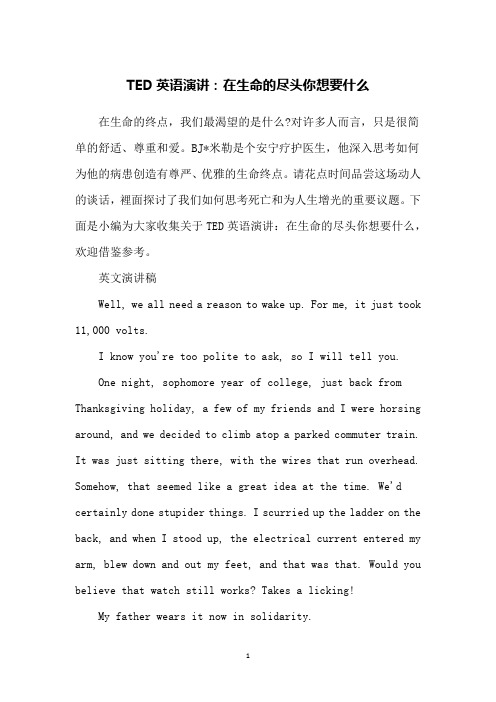
TED英语演讲:在生命的尽头你想要什么在生命的终点,我们最渴望的是什么?对许多人而言,只是很简单的舒适、尊重和爱。
BJ*米勒是个安宁疗护医生,他深入思考如何为他的病患创造有尊严、优雅的生命终点。
请花点时间品尝这场动人的谈话,裡面探讨了我们如何思考死亡和为人生增光的重要议题。
下面是小编为大家收集关于TED英语演讲:在生命的尽头你想要什么,欢迎借鉴参考。
英文演讲稿Well, we all need a reason to wake up. For me, it just took 11,000 volts.I know you're too polite to ask, so I will tell you.One night, sophomore year of college, just back from Thanksgiving holiday, a few of my friends and I were horsing around, and we decided to climb atop a parked commuter train. It was just sitting there, with the wires that run overhead. Somehow, that seemed like a great idea at the time. We'd certainly done stupider things. I scurried up the ladder on the back, and when I stood up, the electrical current entered my arm, blew down and out my feet, and that was that. Would you believe that watch still works? Takes a licking!My father wears it now in solidarity.That night began my formal relationship with death -- my death -- and it also began my long run as a patient. It's a good word. It means one who suffers. So I guess we're all patients.Now, the American health care system has more than its fair share of dysfunction -- to match its brilliance, to be sure. I'm a physician now, a hospice and palliative medicine doc, so I've seen care from both sides. And believe me: almost everyone who goes into healthcare really means well -- I mean, truly. But we who work in it are also unwitting agents for a system that too often does not serve.Why? Well, there's actually a pretty easy answer to that question, and it explains a lot: because healthcare was designed with diseases, not people, at its center. Which is to say, of course, it was badly designed. And nowhere are the effects of bad design more heartbreaking or the opportunity for good design more compelling than at the end of life, where things are so distilled and concentrated. There are no do-overs.My purpose today is to reach out across disciplines and invite design thinking into this big conversation. That is, to bring intention and creativity to the experience of dying. We have a monumental opportunity in front of us, before one of the few universal issues as individuals as well as a civil society:to rethink and redesign how it is we die.So let's begin at the end. For most people, the scariest thing about death isn't being dead, it's dying, suffering. It's a key distinction. To get underneath this, it can be very helpful to tease out suffering which is necessary as it is, from suffering we can change. The former is a natural, essential part of life, part of the deal, and to this we are called to make space, adjust, grow. It can be really good to realize forces larger than ourselves. They bring proportionality, like a cosmic right-sizing. After my limbs were gone, that loss, for example, became fact, fixed -- necessarily part of my life, and I learned that I could no more reject this fact than reject myself. It took me a while, but I learned it eventually. Now, another great thing about necessary suffering is that it is the very thing that unites caregiver and care receiver -- human beings. This, we are finally realizing, is where healing happens. Yes, compassion -- literally, as we learned yesterday -- suffering together.Now, on the systems side, on the other hand, so much of the suffering is unnecessary, invented. It serves no good purpose. But the good news is, since this brand of suffering is made up, well, we can change it. How we die is indeed something we canaffect. Making the system sensitive to this fundamental distinction between necessary and unnecessary suffering gives us our first of three design cues for the day. After all, our role as caregivers, as people who care, is to relieve suffering -- not add to the pile.True to the tenets of palliative care, I function as something of a reflective advocate, as much as prescribing physician. Quick aside: palliative care -- a very important field but poorly understood -- while it includes, it is not limited to end of life care. It is not limited to hospice. It's simply about comfort and living well at any stage. So please know that you don't have to be dying anytime soon to benefit from palliative care.Now, let me introduce you to Frank. Sort of makes this point. I've been seeing Frank now for years. He's living with advancing prostate cancer on top of long-standing HIV. We work on his bone pain and his fatigue, but most of the time we spend thinking out loud together about his life -- really, about our lives. In this way, Frank grieves. In this way, he keeps up with his losses as they roll in, so that he's ready to take in the next moment. Loss is one thing, but regret, quite another. Frank has always been an adventurer -- he looks like something out of aNorman Rockwell painting -- and no fan of regret. So it wasn't surprising when he came into clinic one day, saying he wanted to raft down the Colorado River. Was this a good idea? With all the risks to his safety and his health, some would say no. Many did, but he went for it, while he still could. It was a glorious, marvelous trip: freezing water, blistering dry heat, scorpions, snakes, wildlife howling off the flaming walls of the Grand Canyon -- all the glorious side of the world beyond our control. Frank's decision, while maybe dramatic, is exactly the kind so many of us would make, if we only had the support to figure out what is best for ourselves over time.So much of what we're talking about today is a shift in perspective. After my accident, when I went back to college, I changed my major to art history. Studying visual art, I figured I'd learn something about how to see -- a really potent lesson for a kid who couldn't change so much of what he was seeing. Perspective, that kind of alchemy we humans get to play with, turning anguish into a flower.Flash forward: now I work at an amazing place in San Francisco called the Zen Hospice Project, where we have a little ritual that helps with this shift in perspective. When one of our residents dies, the mortuary men come, and as we're wheelingthe body out through the garden, heading for the gate, we pause. Anyone who wants -- fellow residents, family, nurses, volunteers, the hearse drivers too, now -- shares a story or a song or silence, as we sprinkle the body with flower petals. It takes a few minutes; it's a sweet, simple parting image to usher in grief with warmth, rather than repugnance. Contrast that with the typical experience in the hospital setting, much like this -- floodlit room lined with tubes and beeping machines and blinking lights that don't stop even when the patient's life has. Cleaning crew swoops in, the body's whisked away, and it all feels as though that person had never really existed. Well-intended, of course, in the name of sterility, but hospitals tend to assault our senses, and the most we might hope for within those walls is numbness -- anesthetic, literally the opposite of aesthetic. I revere hospitals for what they can do;I am alive because of them. But we ask too much of our hospitals. They are places for acute trauma and treatable illness. They are no place to live and die; that's not what they were designed for.Now mind you -- I am not giving up on the notion that our institutions can become more humane. Beauty can be found anywhere. I spent a few months in a burn unit at St. BarnabasHospital in Livingston, New Jersey, where I got really great care at every turn, including good palliative care for my pain. And one night, it began to snow outside. I remember my nurses complaining about driving through it. And there was no window in my room, but it was great to just imagine it coming down all sticky. Next day, one of my nurses smuggled in a snowball for me. She brought it in to the unit. I cannot tell you the rapture I felt holding that in my hand, and the coldness dripping onto my burning skin; the miracle of it all, the fascination as I watched it melt and turn into water. In that moment, just being any part of this planet in this universe mattered more to me than whether I lived or died. That little snowball packed all the inspiration I needed to both try to live and be OK if I did not. In a hospital, that's a stolen moment.In my work over the years, I've known many people who were ready to go, ready to die. Not because they had found some final peace or transcendence, but because they were so repulsed by what their lives had become -- in a word, cut off, or ugly. There are already record numbers of us living with chronic and terminal illness, and into ever older age. And we are nowhere near ready or prepared for this silver tsunami. We need an infrastructure dynamic enough to handle these seismic shiftsin our population. Now is the time to create something new, something vital. I know we can because we have to. The alternative is just unacceptable. And the key ingredients are known: policy, education and training, systems, bricks and mortar. We have tons of input for designers of all stripes to work with.We know, for example, from research what's most important to people who are closer to death: comfort; feeling unburdened and unburdening to those they love; existential peace; and a sense of wonderment and spirituality.Over Zen Hospice's nearly 30 years, we've learned much more from our residents in subtle detail. Little things aren't so little. Take Janette. She finds it harder to breathe one day to the next due to ALS. Well, guess what? She wants to start smoking again -- and French cigarettes, if you please. Not out of some self-destructive bent, but to feel her lungs filled while she has them. Priorities change. Or Kate -- she just wants to know her dog Austin is lying at the foot of her bed, his cold muzzle against her dry skin, instead of more chemotherapy coursing through her veins -- she's done that. Sensuous, aesthetic gratification, where in a moment, in an instant, we are rewarded for just being. So much of it comes down to lovingour time by way of the senses, by way of the body -- the very thing doing the living and the dying.Probably the most poignant room in the Zen Hospice guest house is our kitchen, which is a little strange when you realize that so many of our residents can eat very little, if anything at all. But we realize we are providing sustenance on several levels: smell, a symbolic plane. Seriously, with all the heavy-duty stuff happening under our roof, one of the most tried and true interventions we know of, is to bake cookies. As long as we have our senses -- even just one -- we have at least the possibility of accessing what makes us feel human, connected. Imagine the ripples of this notion for the millions of people living and dying with dementia. Primal sensorial delights that say the things we don't have words for, impulses that make us stay present -- no need for a past or a future.So, if teasing unnecessary suffering out of the system was our first design cue, then tending to dignity by way of the senses, by way of the body -- the aesthetic realm -- is design cue number two. Now this gets us quickly to the third and final bit for today; namely, we need to lift our sights, to set our sights on well-being, so that life and health and healthcare can become about making life more wonderful, rather than justless horrible. Beneficence.Here, this gets right at the distinction between a disease-centered and a patient- or human-centered model of care, and here is where caring becomes a creative, generative, even playful act. "Play" may sound like a funny word here. But it is also one of our highest forms of adaptation. Consider every major compulsory effort it takes to be human. The need for food has birthed cuisine. The need for shelter has given rise to architecture. The need for cover, fashion. And for being subjected to the clock, well, we invented music. So, since dying is a necessary part of life, what might we create with this fact? By "play" I am in no way suggesting we take a light approach to dying or that we mandate any particular way of dying. There are mountains of sorrow that cannot move, and one way or another, we will all kneel there. Rather, I am asking that we make space -- physical, psychic room, to allow life to play itself all the way out -- so that rather than just getting out of the way, aging and dying can become a process of crescendo through to the end. We can't solve for death. I know some of you are working on this.Meanwhile, we can --We can design towards it. Parts of me died early on, and that's something we can all say one way or another. I got toredesign my life around this fact, and I tell you it has been a liberation to realize you can always find a shock of beauty or meaning in what life you have left, like that snowball lasting for a perfect moment, all the while melting away. If we love such moments ferociously, then maybe we can learn to live well -- not in spite of death, but because of it. Let death be what takes us, not lack of imagination.Thank you.中文演讲稿我们都需要一个醒来的理由。
拥抱世界英文演讲稿范文
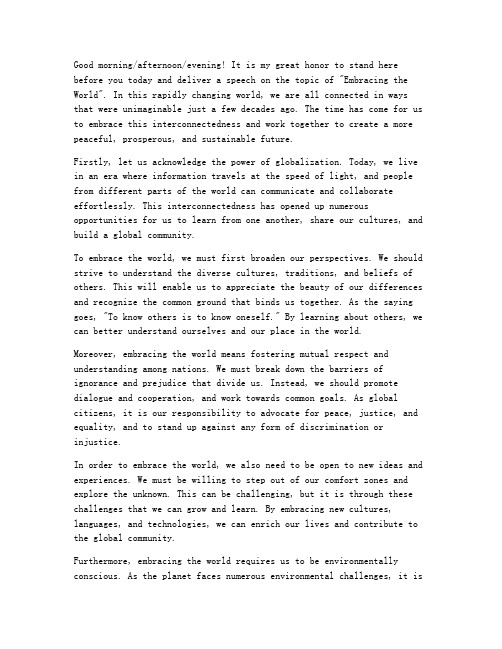
Good morning/afternoon/evening! It is my great honor to stand here before you today and deliver a speech on the topic of "Embracing the World". In this rapidly changing world, we are all connected in ways that were unimaginable just a few decades ago. The time has come for us to embrace this interconnectedness and work together to create a more peaceful, prosperous, and sustainable future.Firstly, let us acknowledge the power of globalization. Today, we live in an era where information travels at the speed of light, and people from different parts of the world can communicate and collaborate effortlessly. This interconnectedness has opened up numerous opportunities for us to learn from one another, share our cultures, and build a global community.To embrace the world, we must first broaden our perspectives. We should strive to understand the diverse cultures, traditions, and beliefs of others. This will enable us to appreciate the beauty of our differences and recognize the common ground that binds us together. As the saying goes, "To know others is to know oneself." By learning about others, we can better understand ourselves and our place in the world.Moreover, embracing the world means fostering mutual respect and understanding among nations. We must break down the barriers of ignorance and prejudice that divide us. Instead, we should promote dialogue and cooperation, and work towards common goals. As global citizens, it is our responsibility to advocate for peace, justice, and equality, and to stand up against any form of discrimination or injustice.In order to embrace the world, we also need to be open to new ideas and experiences. We must be willing to step out of our comfort zones and explore the unknown. This can be challenging, but it is through these challenges that we can grow and learn. By embracing new cultures, languages, and technologies, we can enrich our lives and contribute to the global community.Furthermore, embracing the world requires us to be environmentally conscious. As the planet faces numerous environmental challenges, it iscrucial that we take collective action to protect our natural resources and ensure a sustainable future for generations to come. This means reducing our carbon footprint, conserving energy, and promoting renewable energy sources. By working together, we can create a cleaner, greener world for all.Lastly, let us not forget the power of education. Education is the keyto unlocking the potential of individuals and nations alike. Byinvesting in education, we can empower people to think critically, solve problems, and contribute to the betterment of society. An educated and informed population is more likely to embrace the world and work towards a common good.In conclusion, embracing the world is not an easy task, but it is onethat we must undertake if we are to create a better future for ourselves and for generations to come. By broadening our perspectives, fostering mutual respect, being open to new ideas, being environmentally conscious, and investing in education, we can work together to build a more peaceful, prosperous, and sustainable world.Thank you for your attention, and let us all strive to embrace the world and make it a better place for everyone.。
TED演讲找回生命的力量,从拥抱自己的脆弱开始!

TED演讲找回生命的力量,从拥抱自己的脆弱开始!脆弱感令人无助、自卑,是每个人都曾经或正在经历的。
//////////TED经典演讲《脆弱的力量》讲述人布琳·布朗六年来,围绕这一话题,搜集了成千上万个故事,采访了数以千计的当事人,得到了关于“脆弱的力量”的感知拓展,并彻底改变了她对待工作、生活,如何关爱他人、教育孩子的态度与行为。
01脆弱感的背后是什么?布琳的研究将脆弱感鉴定为羞耻感,这让我想到了6月2日,因性侵罹患抑郁症而离世的17岁荷兰少女Noa,感叹花季少女遭受多少内心的折磨与强烈的羞耻感,才选择离开。
Noa的例子或许极端,但日常生活中,我们也常常感到羞耻、不自信。
我们在意别人的评价,害怕人际关系中存在的不和谐与不确定;更深层地是不能接纳当下的自己,这种不自信、不满足、不认可,无时无刻不蚕食着生命的活力,这种缓释的毒性,危害更加隐蔽而持久,最终会让生活的底色变得暗淡、缺乏生机。
如何面对“脆弱”“不够好”的自己活出生命应有的色彩是人类不断成长的必修课程02直面脆弱的自己我们习惯于听外在的声音,甚至渴求无法计数的“前沿”“高精尖”技术与资讯,似乎了解更多,便能获得更多安全感。
实际上,如果缺乏一颗内观的、安定的心,你很难辨别哪些是真实的,哪些是虚妄的,哪些可以帮你更好的成长,而哪些则是来扰乱你的。
真正的安全感永远都是自己给自己的或者更进一步说它来源于你怎么看待“危险”“不确定”“不完美”一旦你不再被这些词所限制、困扰你摆脱了字面对它们的注释你就获得了真正的安全感我想那应该就是布琳女士所说的“真实地叙述一个故事,告诉大家你是谁”,也就是我想要说的“直面脆弱的自己”。
我们大概都有过这样的经历,不愿谈论某个人,或者避讳谈论某件事,这都源于内在有个脆弱的自己,我们害怕由这件事引发情绪上的波动。
然而,你越害怕某个人或某件事,实际上是以不断“回避”的表象不停“上演”情绪演化的戏码,一次次加大负面的情绪,使你丧失处理某类关系或事件的能力。
TED英语演讲:那些勇敢的女性_演讲稿
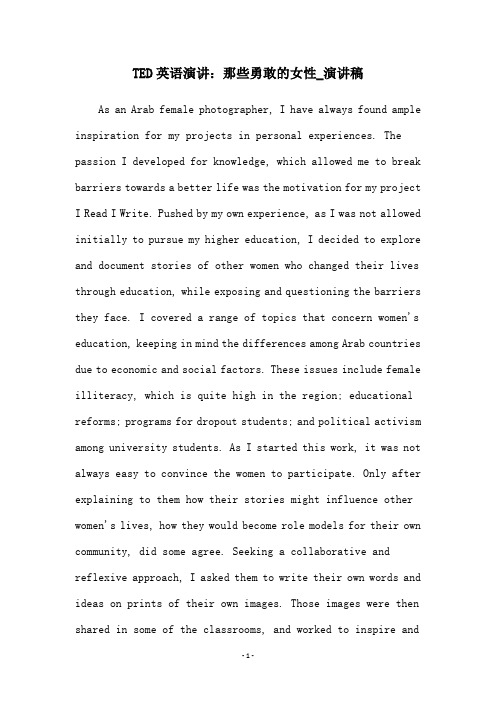
TED英语演讲:那些勇敢的女性_演讲稿As an Arab female photographer, I have always found ample inspiration for my projects in personal experiences. The passion I developed for knowledge, which allowed me to break barriers towards a better life was the motivation for my project I Read I Write. Pushed by my own experience, as I was not allowed initially to pursue my higher education, I decided to explore and document stories of other women who changed their lives through education, while exposing and questioning the barriers they face. I covered a range of topics that concern women's education, keeping in mind the differences among Arab countries due to economic and social factors. These issues include female illiteracy, which is quite high in the region; educational reforms; programs for dropout students; and political activism among university students. As I started this work, it was not always easy to convince the women to participate. Only after explaining to them how their stories might influence other women's lives, how they would become role models for their own community, did some agree. Seeking a collaborative and reflexive approach, I asked them to write their own words and ideas on prints of their own images. Those images were then shared in some of the classrooms, and worked to inspire andmotivate other women going through similar educations and situations. Aisha, a teacher from Yemen, wrote, 'I sought education in order to be independent and to not count on men with everything.'作为一个阿拉伯女摄影师,在个人经历中,我总是找到充分的灵感,做我的项目。
三种万能开场白,赢在开场前30秒
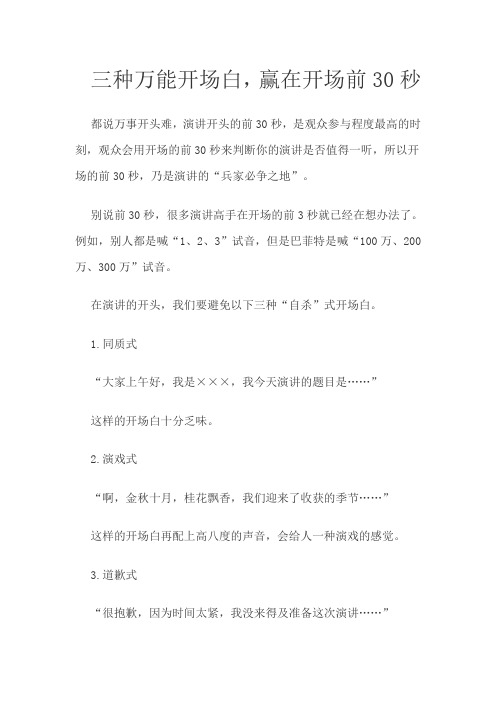
三种万能开场白,赢在开场前30秒都说万事开头难,演讲开头的前30秒,是观众参与程度最高的时刻,观众会用开场的前30秒来判断你的演讲是否值得一听,所以开场的前30秒,乃是演讲的“兵家必争之地”。
别说前30秒,很多演讲高手在开场的前3秒就已经在想办法了。
例如,别人都是喊“1、2、3”试音,但是巴菲特是喊“100万、200万、300万”试音。
在演讲的开头,我们要避免以下三种“自杀”式开场白。
1.同质式“大家上午好,我是×××,我今天演讲的题目是……”这样的开场白十分乏味。
2.演戏式“啊,金秋十月,桂花飘香,我们迎来了收获的季节……”这样的开场白再配上高八度的声音,会给人一种演戏的感觉。
3.道歉式“很抱歉,因为时间太紧,我没来得及准备这次演讲……”“本来我是不想讲的,是×××非要我讲……”观众不希望听到你的借口和道歉,即使观众没有说出来、表现出来,你也不能破坏听众的情绪、浪费听众的时间,因为他们是怀着很大的热情专门花时间来听你的演讲的,所以不要一开始就带给他们消极的信息。
下面我将介绍三种万能开场方式。
此外,道具开场请参考第三章的《讲出画面感——用四个“道具创意”增加演讲战斗力》,问题开场请参考第三章的《讲出转折——用“有问题”的演讲勾住观众的兴趣和注意力》。
承诺开场承诺开场是一开始就告诉观众,他们将会非常享受你的演讲并从中受益。
(1)“今天上午,我们准备了一些非常神奇的东西展示给大家”这样简简单单的一句话,向观众保证了今天有一个最重要的产品将要公布,从而引起观众的兴趣。
(2)“感谢缘分,让我们今晚相约在PPT营销力线上直播课‘7步搞定2020年终总结’,我敢保证这是一次能帮你赚到钱的分享,2 021年升职加薪就靠它了。
”(3)“从现在开始到45分钟之后,当你踏出这扇门的时候,你将收获三项有关幸福的秘密。
”想象开场用“想象”一词开始你的演讲,可以让观众想象一下过去或者未来。
- 1、下载文档前请自行甄别文档内容的完整性,平台不提供额外的编辑、内容补充、找答案等附加服务。
- 2、"仅部分预览"的文档,不可在线预览部分如存在完整性等问题,可反馈申请退款(可完整预览的文档不适用该条件!)。
- 3、如文档侵犯您的权益,请联系客服反馈,我们会尽快为您处理(人工客服工作时间:9:00-18:30)。
TED英语演讲:拯救生命的温暖拥抱每年全球出生的20xx万早产儿中,接近400万活不过第一个月就死去了,特别是在那些贫穷地区。
他们中的大部分因失去体温而死,因为当地没有2万美元的昂贵保暖箱,为此她和她的团队用7年时间研发了一款婴儿保温袋,拯救了数十万早产儿。
下面是小编为大家收集关于TED英语演讲:拯救生命的温暖拥抱,欢迎借鉴参考。
演说题目:拯救生命的温暖拥抱!演说者:JaneChenPlease close your eyes, and open your hands. Now imagine what you could place in your hands: an apple, maybe your wallet. Now open your eyes. What about a life?请闭上眼睛,打开双手,想象下,你们的手中可以放些什么? 一只苹果?或者钱包? 请睁开眼睛. 你曾否想过一个生命?What you see here is a premature baby. He looks like he's resting peacefully, but in fact he's struggling to stay alive because he can't regulate his own body temperature. This baby is so tiny he doesn't have enough fat on his body to stay warm. Sadly, 20 million babies like this are born every year around the world. Four million of these babies die annually.这是一个早产儿。
看起来,他似乎在安睡,但实际上,他正与死神作斗争。
因为他无法调节自己的体温。
这个婴儿实在太小了,他没有足够的脂肪来维持体温。
很悲哀...每年都有两千万这样的婴儿诞生在世界上。
其中的四百万无法存活。
But the bigger problem is that the ones who do survive grow up with severe, long-term health problems. The reason is because in the first month of a baby's life, its only job is to grow. If it's battling hypothermia, its organs can't develop normally, resulting in a range of health problems from diabetes, to heart disease, to low I.Q. Imagine: Many of these problems could be prevented if these babies were just kept warm.但更严重的问题是,如果他们侥幸存活一些慢性病将伴随他们一生。
因为在婴儿诞生的第一个月他们唯一要做的就是成长。
如果体温不稳定,器官不能正常发育随之而来的,就是一连串健康问题如糖尿病,心脏病,或弱智。
想象下,这些问题本可避免只要能让婴儿保暖。
That is the primary function of an incubator. But traditional incubators require electricity and cost up to 20 thousand dollars. So, you're not going to find them in rural areas of developing countries. As a result, parents resort to local solutions like tying hot water bottles around their babies' bodies, or placing them under light bulbs like the ones you see here -- methods that are both ineffective and unsafe. I've seen this firsthand over and over again.给婴儿保暖是恒温箱的主要功能。
但传统的恒温箱需要电源且售价高达2万美元。
在发展中国家的偏远地区,恒温箱根本不存在。
因此,父母们只能就地取材,如在早产儿身体周围绑上热水壶或如你们所看的这张图,将早产儿放在灯泡下-- 这些方法效果差,且不安全。
我多次亲眼目睹这些惨剧。
On one of my first trips to India, I met this young woman, Sevitha, who had just given birth to a tiny premature baby, Rani. She took her baby to the nearest village clinic, and the doctor advised her to take Rani to a city hospital so she could be placed in an incubator. But that hospital was over four hours away, and Sevitha didn't have the means to get there, so her baby died.头几次去印度时,我遇到了这样一位年轻的女性,Sevitha,她刚刚诞下了一个瘦小的早产儿,Rani。
她带着孩子去了村子里最近的诊所,医生建议她带Rani去市区的医院把Rani放在恒温箱里。
但去医院要花四个多小时。
Sevitha没办法去,于是,她的宝贝走了。
Inspired by this story, and dozens of other similar stories like this, my team and I realized what was needed was a local solution, something that could work without electricity, that was simple enough for a mother or a midwife to use, given that the majority of births still take place in the home. We neededsomething that was portable, something that could be sterilized and reused across multiple babies and something ultra-low-cost, compared to the 20,000 dollars that an incubator in the U.S. costs.由这个故事,及其他类似的故事中受到启发,我和我的团队意识到,必须要有一个能够就地取材的办法,一个可不插电的工具,简单易用,不会难倒母亲和产婆,因为大多数的婴儿仍然是在家中被接生的。
这个工具需方便携带,能够被消毒,并给不同的婴儿重复使用,价格得极其便宜,远低于两万美元,这就是我们要设计的恒温箱。
So, this is what we came up with. What you see here looks nothing like an incubator. It looks like a small sleeping bag for a baby. You can open it up completely. It's waterproof. There's no seams inside so you can sterilize it very easily. But the magic is in this pouch of wax. This is a phase-change material. It's a wax-like substance with a melting point of human body temperature, 37 degrees Celsius. You can melt this simply using hot water and then when it melts it's able to maintain one constant temperature for four to six hours at a time, after which you simply reheat the pouch. So, you then place it into this little pocket back here, and it creates a warm micro-environment for the baby.这就是我们的成果。
它看起来一点也不像个恒温箱。
反似婴儿用的睡袋。
你可以把它完全打开。
它是防水的。
无缝设计,便于消毒。
但神奇的地方就在这一包蜡里。
这是一种渐变性材料。
形似蜡,融点为人体体温 37摄氏度。
用热水就可以把它融化当它融化时,它将保持恒定的温度每次维持4到6小时,之后,你可以对包囊再加热。
将它放在背后的小口袋里,它会为婴儿营造一个温暖的小环境。
Looks simple, but we've reiterated this dozens of times by going into the field to talk to doctors, moms and clinicians to ensure that this really meets the needs of the local communities. We plan to launch this product in India in 20xx, and the target price point will be 25 dollars, less than 0.1 percent of the cost of a traditional incubator.看似简单,但我们为此多次造访当地的医生,母亲,诊所以确保它能满足当地的要求。
